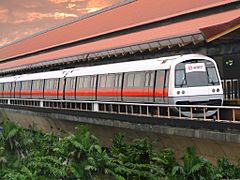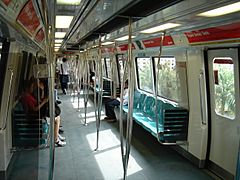- This page was last modified on 17 October 2025, at 10:18. Suggest an edit.
Kawasaki Heavy Industries & Nippon Sharyo C751B facts for kids
The Kawasaki Heavy Industries & Nippon Sharyo C751B, often called C751B, is a type of electric train used in Singapore. It's the third generation of trains to run on the North South and East West Lines of Singapore's MRT system. These trains started carrying passengers in early 2000.
|
Kawasaki Heavy Industries & Nippon Sharyo (KNS) C751B
|
|
|---|---|

A C751B trainset at Eunos.
|
|

Interior of a C751B motor compartment.
|
|
| In service | 8 May 2000 – Present |
| Manufacturer | Kawasaki Heavy Industries and Nippon Sharyo |
| Built at | Kobe, Japan |
| Constructed | 1999 – 2001 |
| Entered service | 2000 |
| Number built | 126 vehicles (21 trainsets) |
| Number in service | 126 vehicles (21 trainsets) |
| Formation | 6 per trainset DT–M1–M2–M2–M1–DT |
| Fleet numbers | 311/312 ~ 351/352 |
| Capacity | 1920 passengers 276/288 seats |
| Operator(s) | SMRT Trains (SMRT Corporation) |
| Depot(s) | Bishan Changi Tuas Ulu Pandan East Coast (Future) |
About the C751B Trains
There are 21 of these C751B trains. Each train has 6 cars, making them long enough to carry many passengers. These trains were quite an investment, costing about S$231 million in total.
The C751B trains were the first in Singapore to use a special power control system called VVVF. This system helps the train run smoothly and efficiently. The way these trains move is similar to some trains in Japan, like the Sanyo 5030 series.
Who Built These Trains?
The C751B trains were built by two different companies from Japan. Kawasaki Heavy Industries made 66 of the train cars. The other company, Nippon Sharyo, built 60 cars. Even though two different companies made them, all the cars look and work the same. This is because they were all built following the same detailed plans.
Related Trains
If you're interested in other trains used in Singapore, you might like to learn about these:
Images for kids
-
The C751B was also the first EMU in Singapore to be fitted with the Train Information Management System (TIMS) also used onboard Japanese trains


